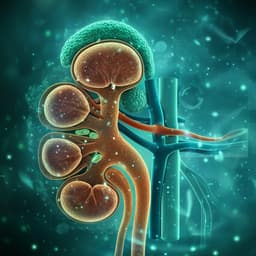
Environmental Studies and Forestry
EARLY BUD-BREAK 1 and EARLY BUD-BREAK 3 control resumption of poplar growth after winter dormancy
A. Azeez, Y. C. Zhao, et al.
This research unveils key molecular mechanisms behind bud-break in trees and shrubs, highlighting the interplay between transcription factors EBB1 and SVL, and introducing the EBB3 gene as a temperature-responsive regulator. Conducted by a team of experts including Abdul Azeez, Yiru Chen Zhao, and others, this study sheds light on the relationship between temperature, bud-break, and the activation of the cell cycle.
Playback language: English
Introduction
The transition between periods of active growth and dormancy is a crucial adaptation for plants in seasonal climates, enabling survival during unfavorable conditions like low temperatures or moisture stress. In boreal and temperate woody perennials, winter bud dormancy develops in autumn, involving growth cessation, bud formation (bud-set), and dormancy establishment. In many woody plants, including *Populus*, growth cessation and dormancy induction are triggered or accelerated by short days (SDs) and prevented or delayed by long days (LDs). This process integrates photoperiod detection and growth inhibition through the convergence of circadian clock machinery (involved in photoperiod sensing) on the FT (*FLOWERING LOCUS T*) regulatory hub. In poplar, clock components like *LHY1* (*LATE ELONGATED HYPOCOTYL 1*), *LHY2*, *GI* (*GIGANTEA*), and *CO1/2* (*CONSTANS*) regulate *FT2* (a poplar *FT* paralog) expression according to day length. High *FT2* expression promotes active growth, whereas *FT2* repression leads to growth cessation and bud set. Downstream signaling involves *Like-APETALA1* (*LAP1*), which positively regulates *AINTEGUMENTA-Like 1* (*AIL1*), and *AIL1* regulates D-type cyclins, crucial for cell cycle progression. Thus, growth cessation and bud-set utilize genes and pathways that also regulate photoperiodic floral initiation.After growth cessation and bud set, continuous SD exposure leads to dormancy establishment, rendering buds insensitive to growth-promoting signals. Abscisic acid (ABA) plays a significant role in this process. Under SDs, ABA concentration and signaling increase, promoting callose biosynthesis and deposition at plasmodesmata (PD), forming PD sphincters. These symplastic blockages isolate the shoot apical meristem (SAM) from growth-promoting signals.Dormancy release and growth resumption require prolonged exposure to low temperatures. This ensures growth only after favorable conditions return. While both LDs and warm temperatures are needed for growth resumption, warm temperatures are the dominant trigger. Unlike the photoperiod-regulated growth cessation and dormancy establishment, dormancy release and growth reactivation are primarily thermo-regulated. The molecular mechanisms underlying temperature control of dormancy release and bud-break remain largely unknown.The discovery of Dormancy Associated MADS-box (DAM) genes in evergreen peach mutants suggested potential similarities between dormancy release/bud-break and vernalization. DAM genes and MADS-box genes like *FLOWERING LOCUS C* (*FLC*) are repressed during vernalization (by low temperatures), with expression changes correlating with histone modifications. However, the relevance to deciduous plants that undergo growth cessation is unclear. Recently, a poplar gene, SVP-like (SVL), homologous to *Arabidopsis SVP*, was identified as a negative regulator of bud-break, acting downstream of ABA signaling. The poplar *EARLY BUD-BREAK 1* (*EBB1*) gene, encoding an AP2/ERF transcription factor, was previously identified as a positive regulator of bud-break. However, its interaction with the SVL pathway remained unclear. This research addresses these gaps by investigating the interaction between *EBB1*, *SVL*, and a newly identified gene, *EBB3*.
Literature Review
Previous research has established the importance of photoperiod and temperature in regulating bud dormancy and bud break in trees. Studies on poplar have identified key genes involved in these processes, including *FLOWERING LOCUS T* (*FT*), *CONSTANS* (*CO*), and *GIGANTEA* (*GI*), which play roles in photoperiodic growth control and dormancy establishment. Other studies have shown the role of abscisic acid (ABA) in dormancy induction and the importance of chilling requirements for dormancy release. The identification of Dormancy Associated MADS-box (DAM) genes has hinted at potential links between dormancy release and vernalization. However, a comprehensive understanding of the molecular mechanisms governing the interaction between temperature signaling and bud break remained elusive. Prior work by the authors identified *EBB1* as a positive regulator of bud break, but its relationship with other known regulators such as SVL remained to be investigated. This study builds upon this existing literature by exploring the interaction of multiple genes involved in this process.
Methodology
The study utilized a multi-faceted approach combining genetic analysis, molecular biology techniques, and advanced computational methods. Firstly, an activation-tagged *Populus tremula* x *Populus alba* (WT-717) population was screened to identify a mutant exhibiting early bud break, designated *ebb3D*. TAIL-PCR was employed to recover the sequence flanking the insertion of the activation tag, allowing for the identification of candidate genes. The expression of these genes was then compared between the mutant and wild-type plants using qRT-PCR.To pinpoint the causal gene responsible for the early bud break phenotype, both candidate genes flanking the activation tag insertion site were overexpressed in the WT-717 background. Transgenic lines with high overexpression were then evaluated for the *ebb3D* phenotype, which involved assessing bud break timing under controlled growth chamber conditions. To confirm the function of the identified gene, RNAi lines with reduced expression of the gene were generated and evaluated for delayed bud break.The expression pattern of the identified gene was further investigated during the activity-dormancy cycle in both wild-growing aspen trees and plants grown under controlled conditions. This involved exposing plants to short-day photoperiods to induce dormancy, followed by cold treatments for dormancy release, and then long-day photoperiods and warm temperatures to induce bud break. Gene expression was measured at various time points using qRT-PCR. To investigate epigenetic regulation of the identified gene, the levels of H3K27me3, a repressive histone mark, were analyzed at the gene locus before and after cold exposure. Electrophoretic mobility shift assays (EMSAs) and chromatin immunoprecipitation-quantitative PCR (ChIP-qPCR) were employed to determine if the identified gene directly regulates the expression of other key genes in this pathway.In order to explore the regulatory network, expression of other genes in transgenic lines with altered expression of *EBB1* and *SVL* were examined, providing insights into the hierarchical relationships between genes. The effects of ABA treatment and ABA-related transgenic lines on the identified gene's expression were analyzed, shedding light on ABA's role in the regulatory network. Finally, transcriptome analysis of EBB3-RNAi transgenic lines was conducted at various stages of the activity-dormancy cycle, aimed at identifying downstream targets involved in bud break.
Key Findings
The study identified *EARLY BUD-BREAK 3* (*EBB3*) as a novel positive regulator of bud break in poplar. Overexpression of *EBB3* resulted in significantly earlier bud break, while suppression led to significantly delayed bud break, confirming its crucial role. *EBB3* expression showed strong correlation with dormancy release and bud break; it was low during dormancy and highly upregulated during winter and spring, peaking just before or at bud break. Low temperatures, essential for dormancy release, positively regulated *EBB3* expression, and this regulation was found to involve epigenetic changes: Specifically, a reduction in H3K27me3 (a repressive histone mark) at the *EBB3* locus was observed after exposure to low temperatures, correlating with *EBB3* upregulation.The study demonstrated a direct interaction between *EBB1* and *SVL*, showing that *EBB1* directly represses *SVL* expression. *EBB1* acts as a direct upstream repressor of *SVL*. *EBB3* was shown to be downstream of both *EBB1* and *SVL*. The expression of *EBB3* was significantly upregulated in *EBB1* overexpressing plants and downregulated in *EBB1* downregulated plants. Further, *EBB3* was shown to be negatively regulated by *SVL*. ABA, a known bud break suppressor, was found to negatively regulate *EBB3* expression. ABA treatment significantly downregulated *EBB3* expression, and *EBB3* expression was significantly higher in *abil-1* transgenic hybrid aspen with reduced ABA response compared to wild type plants. Transcriptome analysis of *EBB3*-RNAi lines revealed *CYCD3.1* as a direct downstream target of *EBB3*. *EBB3* was found to bind directly to the promoter of *CYCD3.1* and positively regulate its expression. *CYCD3.1* is a key regulator of cell cycle progression, and its upregulation correlates with bud break.
Discussion
The findings elucidate a key regulatory pathway involving three transcription factors (*EBB1*, *SVL*, and *EBB3*) that control bud break in poplar. *EBB1* acts upstream, negatively regulating *SVL* expression. *SVL*, in conjunction with ABA, acts upstream of *EBB3*, negatively regulating its expression. *EBB3*, in turn, directly and positively regulates *CYCD3.1*, a cell cycle regulator crucial for bud break. This intricate network integrates temperature signaling with cell cycle control, revealing how environmental cues influence growth resumption.The interplay between *EBB1*, *SVL*, and ABA is particularly noteworthy. *EBB1* counteracts the *SVL*/ABA positive feedback loop, which is crucial for dormancy maintenance. As temperatures decrease, *EBB1* is downregulated, allowing *SVL*/ABA to promote dormancy. As temperatures rise, *EBB1* upregulation represses *SVL*, breaking the feedback loop and enabling bud break.The epigenetic regulation of *EBB3* by low temperatures adds another layer of complexity. The decrease in H3K27me3 histone marks at the *EBB3* locus following cold exposure suggests a mechanism by which low temperatures directly influence *EBB3* expression, contributing to dormancy release and bud break.The identification of *CYCD3.1* as a direct target of *EBB3* provides a direct link between this regulatory network and the cell cycle machinery. *EBB3* activation likely initiates cell proliferation, directly leading to bud break. These findings highlight the significance of coordinating environmental cues with cell cycle regulation to control this crucial developmental process.
Conclusion
This research uncovered a novel regulatory pathway involving *EBB1*, *SVL*, and *EBB3* that governs bud break in poplar. This pathway integrates temperature and hormonal signaling with cell cycle control, elucidating the molecular mechanisms governing this critical process. The epigenetic regulation of *EBB3* highlights a novel mechanism for responding to low temperatures. The identification of *CYCD3.1* as a direct target of *EBB3* reveals a crucial link between this regulatory network and the cell cycle. These findings provide a foundation for future research aimed at manipulating bud break timing in poplar and other tree species to mitigate the challenges posed by climate change.
Limitations
The study focused primarily on poplar, and the generality of these findings to other tree species requires further investigation. While the findings suggest a hierarchical relationship between the genes, further experiments, such as the generation of double and triple mutants, are needed to confirm the complete regulatory architecture. The study primarily focused on the transcriptional regulation of bud break; exploring the roles of post-translational modifications and other regulatory layers would enhance the overall understanding of this complex process. The epigenetic studies focused on a specific histone mark; investigating other epigenetic modifications might reveal additional regulatory mechanisms.
Related Publications
Explore these studies to deepen your understanding of the subject.







